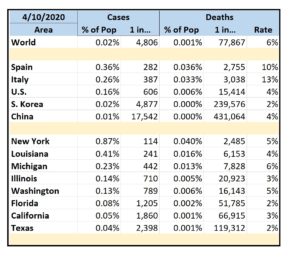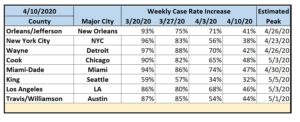While the World Health Organization hasn’t yet categorized the COVID-19 coronavirus outbreak as a pandemic, that’s just a formality. It is a pandemic.
As of this writing, there were 90,933 cases in 76 countries resulting in 3,120 deaths. In the U.S., there were 103 reported cases resulting in 6 deaths. All of these numbers will get much worse before they get better. For those so inclined, here’s a helpful (but rather depressing) website with up-to-date COVID-19 statistics.
Since this is a political blog, let me explicitly state what should be patently obvious: COVID-19 doesn’t have a political agenda. As much as I might like to blame it on Trump, it’s not his fault. Likewise, the associated stock market drop wasn’t his fault, either.
But here’s the problem. Trump and his minions have gone out of their way to make this a political issue.
While loss of life should be a more pressing concern, Trump has been mostly focused on the economic (and thus political) impact of COVID-19. In efforts to prop up the stock market, Trump has been clearly downplaying the outbreak with various distortions and outright lies. Over the course of just a week, he has floated numerous approaches. He’s claimed that it’s a Democratic “hoax” with no explanation whatsoever. He’s claimed that everything is under control in the U.S. when it clearly is not. He’s claimed that a vaccine and/or a cure will be available within a few months when experts say nothing will be available for at least a year and a half. He’s claimed that the virus will probably die out in the warmer April timeframe while experts say otherwise. In short, Trump doesn’t know what he’s talking about – which isn’t exactly breaking news.
Concurrently, Trump’s enablers have been even worse. A GOP House candidate is pushing a theory that Democrats created the virus. Sen. Tom Cotton opined that the virus was a man-made Chinese bio-weapon. Rush Limbaugh, the newly Trump-minted Presidential Medal of Freedom recipient, repeated Cotton’s theory while also claiming that “the coronavirus is the common cold” and an anti-Trump conspiracy. Larry Kudlow, Trump’s National Economic Council Director, claimed that the virus was “contained” in the U.S. and “pretty close to airtight” – whatever the hell that meant. Trump Jr. actually claimed that Democrats want millions of people to die just to bring down his father. And then, to top it off, Vice President Mike Pence defended the Republican rhetoric as “justified”.
Thus, while it’s sad that COVID-19 is even a valid topic for a political blog, I’ll reluctantly take a look at it from a political perspective.
Let’s first get the stock market out of the way. I personally took a rather large financial hit recently, so I’m not exactly thrilled. However, the market is going to do what the market damn well wants to do, largely regardless of who happens to be in the White House. To my mind, there is only one reason that the stock market is a political issue. Since Trump has loudly and repeatedly claimed full and personal credit for the bull market since his election, it only seems fair that he should take full and personal blame for a bear market. I’m simply not accepting alternative viewpoints here.
So now to the real issue. The handling of a national health emergency is clearly the responsibility of the executive branch of our government and this administration’s preparation and response to COVID-19 has been clearly pathetic.
Trump made massive budget cuts to the CDC – the agency tasked with leading our nation’s response to health emergencies such as the one we’re currently facing. In defense of those cuts, Trump said, “I’m a businessperson. I don’t like having thousands of people around when you don’t need them.” By Trump’s logic, perhaps we should disband the military until we need to send someone to a war zone.
Those CDC cuts had a cascading effect on the agency’s response to COVID-19. Until just recently, only a very small number of laboratories were enabled to run tests for the virus. Worse still, the testing kits that were initially sent out by the CDC had a faulty component. Thus, the number of COVID-19 cases in the U.S. is likely much higher than is currently being reported. HHS Secretary Alex Azar initially denied that the test kits were faulty despite a concurrent statement by the CDC admitting otherwise. The administration’s response wasn’t to transparently correct the misinformation but rather to clamp down on all statements made by non-political appointees. Of course it was.
Such incompetence has been rampant. In my home state of Texas, the CDC mistakenly released a woman from quarantine who tested positive for the virus. They didn’t get her back until after she’d potentially spread the virus at a busy mall. This was such a massive display of stupidity that even our very Republican governor complained.
Trump & Company have also been less than helpful in their characterizations of COVID-19. It is most certainly not the common cold and it is considerably worse than the flu. COVID-19 currently appears to have a mortality rate of 1-2 percent. While that might not seem particularly high, it’s 10-20 times the mortality rate of the flu. Furthermore, the fact that some 80% of people infected with COVID-19 will only experience minor symptoms only means that those people will likely continue to go about their daily routines spreading the virus to others.
Even a relatively minor outbreak of COVID-19 could easily overwhelm healthcare facilities and experts have warned that a coronavirus pandemic could eventually impact 40-80 percent of the world’s population. If we assume a U.S. population of 331 million people, a 40% infection rate, and a 1% mortality rate, we’d see 1.3 million COVID-19 deaths in the U.S. alone.
And, finally, as the icing on this virus-infected cake, Trump appointed Mike Pence to head up the Coronavirus Task Force. Our national effort to confront a worldwide pandemic is being led not by an expert in the field, but by an anti-science Trump acolyte who, as governor of Indiana, oversaw a truly horrific response to the largest HIV outbreak in that state’s history. Just yesterday, Pence claimed “the risk remains low” with respect to COVID-19. So there you have it. I guess there’s nothing at all to worry about.
Sure, Democratic lawmakers have been pointing out all of the above to hold the Trump administration accountable. That’s their job. They’re not creating the narrative and they’re not claiming that Republicans want people to die. They’re simply pointing out that the Trump administration isn’t doing its job. That’s just a fact. Nevertheless, Democrats are cooperating with the Trump administration’s emergency CDC funding requests despite the fact that Democrats wanted the CDC funding in the budget in the first place.
Of course COVID-19 will be an issue in the 2020 general election. It should be. This is the first real crisis that the Trump administration has had to address. If they somehow have things under control by November, then they may deserve some credit. If they continue to mismanage the pandemic, then they need to answer to the voters.
Until then, however, a pandemic isn’t a political football. I don’t want to hear the Trump administration’s opinions about the direction of the stock market, I don’t want to hear how Democrats are somehow to blame, and I don’t want to hear COVID-19 status updates from career politicians. In fact, I don’t want politicians anywhere near the podium when experts in the field calmly present all the facts and lay out exactly what steps are being taken.
I’m just not holding my breath. Although perhaps I should be.


